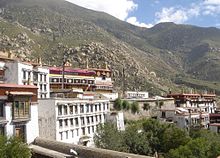| Drepung Monastery | |
|---|---|
Tibetan transcription(s) Tibetan: འབྲས་སྤུངས་ Wylie transliteration: ’bras spungs Pronunciation in IPA: [[ˈtʂɛpuŋ]] Official transcription (China): Zhaibung THL: Drepung Other transcriptions: Dräpung[citation needed], Drebung[citation needed] Chinese transcription(s) Traditional: 哲蚌寺 Simplified: 哲蚌寺 Pinyin: Zhébàng Sì | |
 Drepung Monastery | |
| Religion | |
| Affiliation | Tibetan Buddhism |
| Sect | Gelug |
| Deity | Je Tsongkhapa |
| Location | |
| Location | Mount Gephel, Lhasa, Tibet Autonomous Region, China |
| Country | China |
Location within Tibet Autonomous Region | |
| Geographic coordinates | 29°40′35″N 91°2′51″E / 29.67639°N 91.04750°E |
| Architecture | |
| Founder | Jamyang Chojey |
| Date established | 1416 |
| Part of a series on |
| Tibetan Buddhism |
|---|
 |
Drepung Monastery (Tibetan: འབྲས་སྤུངས་དགོན་པ, Wylie: bras spungs dgon pa, THL: drépung gönpa,[1] "Rice Heap Monastery"),[2][3] located at the foot of Mount Gephel, is one of the "great three" Gelug university gompas (monasteries) of Tibet. The other two are Ganden Monastery and Sera Monastery.
Drepung is the largest of all Tibetan monasteries and is located on the Gambo Utse mountain, five kilometers from the western suburb of Lhasa.
Freddie Spencer Chapman reported, after his 1936–37 trip to Tibet, that Drepung was at that time the largest monastery in the world, and housed 7,700 monks, "but sometimes as many as 10,000 monks."[4][5]
Since the 1950s, Drepung Monastery, along with its peers Ganden and Sera, have lost much of their independence and spiritual credibility in the eyes of Tibetans since they operate under the close watch of the Chinese security services.[citation needed] All three were re-established in exile in the 1950s in the state of Karnataka in south-west India. Drepung and Ganden are in Mundgod and Sera is in Bylakuppe.
- ^ TBRC
- ^ Tibet, Tibet: A Personal History of a Lost Land. Patrick French. (2003) Alfred A. Knopf. New York City, p.240 (in quote from 13th Dalai Lama).
- ^ Dialogues Tibetan Dialogues Han. Hannue. Quoting a monk at Drepung.
- ^ Chapman F. Spencer. Lhasa the Holy City, p. 195. Readers Union Ltd., London.
- ^ "What we don't hear about Tibet" Archived 2017-12-14 at the Wayback Machine, The Guardian (Comment is Free). (Wednesday 11 February 2009 22.00 GMT)
